Is An Electric Toothbrush Really Better?
The other day my neighborhood lost power for over twelve hours, an unusually long period of time for us. Not only was there no electricity, but there was no internet, no cell phone coverage, and most importantly, no heat! Since it was Sunday, I put on another layer of clothing, got under a blanket, and continued reading a fascinating book that I never seemed to find time to read.
The experience got me thinking how much we rely on electricity in our lives, everything from operating a microwave oven to our cell phone addiction. Never mind all the “smart” systems in our house…do we even know how to open our garage door manually? And what about our electric toothbrushes? Does anyone really need an electric toothbrush?
Some people will greatly benefit from an electric brush.
While no one needs an electric brush, it is recommended for certain groups. These include:
Children and teenagers
As this group tends to rush through brushing, an electric brush can prolong the brushing time. There are also features that may make brushing more fun for children.
Seniors
Motor skills and eyesight may diminish with age. An electric brush makes much of the brushing automatic.
Anyone with a physical disability such as a broken dominant arm or Parkinson’s disease
Anyone with a cognitive disability like dementia or Down syndrome
Anyone wearing braces
It’s more difficult to clean around wires and brackets.
But does an electric brush do a better job?
A 2019 study aimed to answer this very question. The researchers followed almost 3,000 people for over 11 years. They found that sonic toothbrushes reduce the signs of gum (periodontal) disease and the number of teeth lost. Other studies have concluded that electric toothbrushes are more effective than manual ones at removing plaque, one of the main culprits of cavities and gum disease.
What to look for with an electric brush
You don’t need anything fancy. Like cars, electric brushes are available with many options, such as different pressure settings. There’s also pressure on brush manufacturers to introduce new and improved features every year. Some brushes are now “smart” with Bluetooth capabilities. Brushing time can be recorded and tracked. Some apps provide coaching or encouragement which may be beneficial for children. There are even apps that treat brushing like a game to incentivize children to brush.
The cost of the toothbrush is generally tied to the number of enhanced features. When picking a brush, consider which features you will definitely use. While some characteristics may sound appealing, they sometimes border on the gimmicky. For example, some brushes come with a UV light that claims to disinfect the brush between uses. Most experts agree that effective destruction of bacteria, viruses, and fungi with a UV light is dependent upon a host of complicated factors and not as simple as it seems.
A basic brush with the following may serve you best.
Size matters
Sonic brushes come with either a small, round head or a rectangular one that more approximates a manual brush. Which fits in your mouth better?
A timer
Almost all brushes are equipped with a two-minute timer that beeps every 30 seconds, signaling you to move from one quadrant to the next. Some brushes even automatically turn off after two minutes to prevent overbrushing.
Replacement brush heads
Just like your manual toothbrush, brush heads should be changed every two to three months, or at the first sign of fraying bristles. Heads should also be changed after an illness such as a cold. Ensure that replacement brush heads are readily available, particularly if you’re purchasing a less expensive model which may be discontinued in the near future.
If you do a fair amount of traveling, consider the bulkiness of the brush. Some brushes come with travel cases. Since brushing techniques differ, it’s advisable not to switch between a manual and electric brush on a regular basis
How to use your electric brush
The biggest difference between an electric brush and a manual one is that you will hold the electric brush passively and guide it from tooth to tooth. Let the brush do the work for you. Resist the urge to apply additional hand pressure.
Helpful hint: At the beginning, consider holding your electric brush with your non-dominant hand. Without that muscle memory, you may be less likely to apply undue force.
Electric brushes can be ticklish, and for a rare few, this may be an intolerable situation. If you’re excessively ticklish elsewhere, consider experimenting with a loved one’s electric brush first. Insert a new brush head and give it a whirl.
What if you want to continue using your manual brush?
Follow this simple rule: Brush softly with a soft-bristled brush. You can brush too hard and cause irreversible damage to your gums. Regardless of whether the bristles are nylon or plant based, stick with soft. Boar bristles should be avoided as they’re stiffer than nylon.
Again, you don’t need anything fancy. A toothbrush can be purchased for as little as two dollars. But if that stylish, Scandinavian toothbrush has caught your eye – and you don’t mind paying five to ten times more, go for it.
Eco-friendly toothbrushes
Bamboo toothbrushes seem to be all the rage, advertised with the following features:
Biodegradable
Obviously wood will eventually degrade back into the earth, whereas plastic lasts forever in landfills.
Eco-friendly
Regardless of the source, toothbrushes have to be mass produced in large scale facilities. A wood product like bamboo – incidentally very fast growing - must additionally be harvested and replenished to maintain its environmental impact.
Antibacterial
Bamboo is naturally resistant to most bacteria, making it a potentially ideal candidate for cutting boards and the like. However, only the shaft of the brush is made from bamboo and the bristles are not antibacterial. Besides, our mouths contain a treasure trove of bacteria.
The bottom line...Regardless of electric or manual, stick to basics:
Select a brush or brush head that’s not too big for your mouth. Ensure there’s enough room to maneuver the brush around.
Only buy a soft-bristled brush. And brush softly.
Change your brush or brush head every 2-3 months. Also change it after you’ve been ill.
Brush for a total of two minutes, 30 seconds in each quadrant.
The most important time to brush is at night before bed.
Saliva flow decreases dramatically during sleep. Not only can saliva help remineralize your teeth, but it also neutralizes the pH in your mouth and helps to combat cavities.
Brush your tongue.
Air dry your brush in between uses.
Do not share your toothbrush with others.







